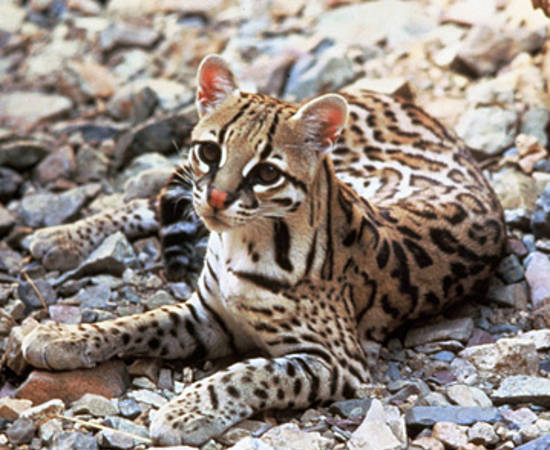

The ocelot (Leopardus pardalis) is a small wild cat species that currently occurs from Northern Argentina up to the southern tip of the United States, where it occurs in Texas and sometimes in Arizona. The International Union for the Conservation of Nature considers ocelots a species of “Least Concern” for extinction range-wide, though the overall ocelot population is decreasing, and ocelots are considered endangered in some countries. In the United States, ocelots have been classified as federally endangered under the Endangered Species Act since 1982.
Historically, ocelots’ range in the United States is believed to have extended throughout Arizona, Texas, Arkansas, and Louisiana. However, historic overexploitation from unregulated hunting, trapping, and poisoning, plus habitat destruction and fragmentation, has left ocelots vulnerable to extirpation from the United States. Today, resident breeding ocelots in the United States may number fewer than 100 individuals in the wild.
All of these breeding individuals occur in deep south Texas near the Gulf of Mexico. Due to their low numbers and isolation from other ocelot populations in Mexico, ocelots in the U.S. are threatened by low genetic diversity. This leaves them vulnerable to the negative impacts of genetic defects, which may be caused by inbreeding, and diseases. Further, because ocelots in Texas all live in low-elevation coastal areas, some worry that the viability of the entire existing U.S. breeding ocelot populations and their habitat could be lost in a single local catastrophic event, such as a high-impact tropical storm along the Gulf coast.
This project has established a visionary, proactive and cooperative blueprint for pooling the strengths, expertise, interests and resources of a diverse set of partners. Partner organizations designing the ocelot reintroduction program represent government agencies, non-governmental organizations, academic institutions, and private landowners. NRI's partners include U.S. Fish and Wildlife Service, the Texas Parks and Wildlife Department, Lindner Center for Conservation and Research of Endangered Wildlife at the Cincinnati Zoo and Botanical Garden, zoological institutions, Caesar Kleberg Wildlife Research Institute, the Karen C. Drayer Wildlife Health Center at University of California Davis, Duquesne University, and East Foundation.
-
Enabling endangered species conservation on private land: A case study of the ocelot in Texas
May 2025
Lindsay Martinez, Tyler Campbell, Roel Lopez -
Long live the cat: Ocelot population viability in a planned reintroduced population in Texas, USA
Nov 2024
Lindsay A. Martinez, Jason V. Lombardi, Israel D. Parker, Forrest East, Tyler A. Campbell, Roel R. Lopez -
Assessing ecological and socio-political factors in site selection for ocelot reintroduction in Texas
Mar 2024
Lindsay A. Martinez, Jason V. Lombardi, Garrett Powers, Amanda D. Anderson, Tyler Campbell, Roel R. Lopez





